8 Stunning Kyoto Gardens That Will Take Your Breath Away
As you explore the serene landscapes of Kyoto's gardens, you'll find each one holds a story etched into its paths and ponds. From the reflective tranquility of the Golden Pavilion at Kinkaku-ji to the philosophical depths of the Zen stone garden at Ryoan-ji, these gardens are not just stunning; they're a journey through the aesthetics of Japanese culture. They invite you to ponder life's impermanence amidst their seasonal beauty—be it the lush greens of summer or the fiery maples in autumn. But what is it about these gardens that captures the essence of Kyoto so perfectly? Let's explore the elements that make them a must-visit.
Kinkaku-ji: The Golden Pavilion
Kinkaku-ji, also known as the Golden Pavilion, dazzles visitors with its stunning gold-leaf coating that shines brilliantly beside its surrounding pond. As you wander through this historic site in Kyoto, you'll find yourself enveloped in its majestic charm and rich history. Originally built in the late 14th century as a retirement villa for Shogun Ashikaga Yoshimitsu, it's now a Zen Buddhist temple that captures the essence of Kitayama culture, emphasizing the harmony between architecture and landscape.
The pavilion consists of three floors, each showcasing a different style of architecture. The first floor, constructed in the Shinden style, used primarily during the Heian Period, contrasts with the upper floors that feature the Samurai-style Bukke architecture. What's truly mesmerizing is how each floor seems to reflect differently on the mirror-like pond, changing its appearance with the seasons.
Surrounded by lush gardens, each step you take offers a new perspective, with the carefully placed trees framing views of the pavilion in a way that seems almost surreal. Whether you visit during the vibrant green of spring or the fiery colors of autumn, Kinkaku-ji remains a breathtaking sight, a masterpiece of Japanese aesthetics that you won't soon forget.
Ryoan-ji: Zen Stone Garden
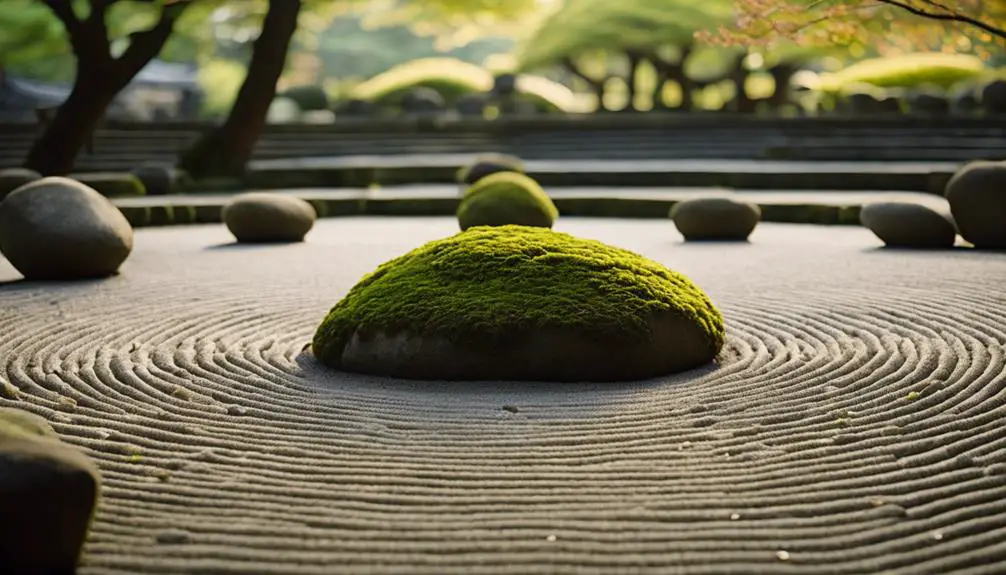
Continuing your exploration of Kyoto's serene landscapes, next visit the iconic Ryoan-ji, famous for its enigmatic Zen stone garden. This historic temple offers a stark yet profound beauty that's unique even in Kyoto's rich tapestry of gardens. The rock garden at Ryoan-ji, a UNESCO World Heritage site, is a minimalist masterwork, devoid of the lush greens that characterize many other Japanese gardens. Instead, it features fifteen carefully placed rocks on a bed of finely raked white gravel.
As you step into the viewing area, you'll notice the garden's rectangular form which encourages contemplation from various angles. Remarkably, no matter where you stand, you can't see all fifteen stones at once; this design choice is a deliberate element to spark meditation and reflection. It's said that achieving a view of all stones simultaneously is akin to gaining full enlightenment.
Besides the stone garden, Ryoan-ji also boasts a serene water feature and a moss garden that contrasts with the starkness of the rocks. These elements blend to offer a holistic sense of peace.
Take your time here; let the simplicity and stillness wash over you, allowing a moment of Zen to permeate your busy travel schedule.
Ginkaku-ji: The Silver Pavilion
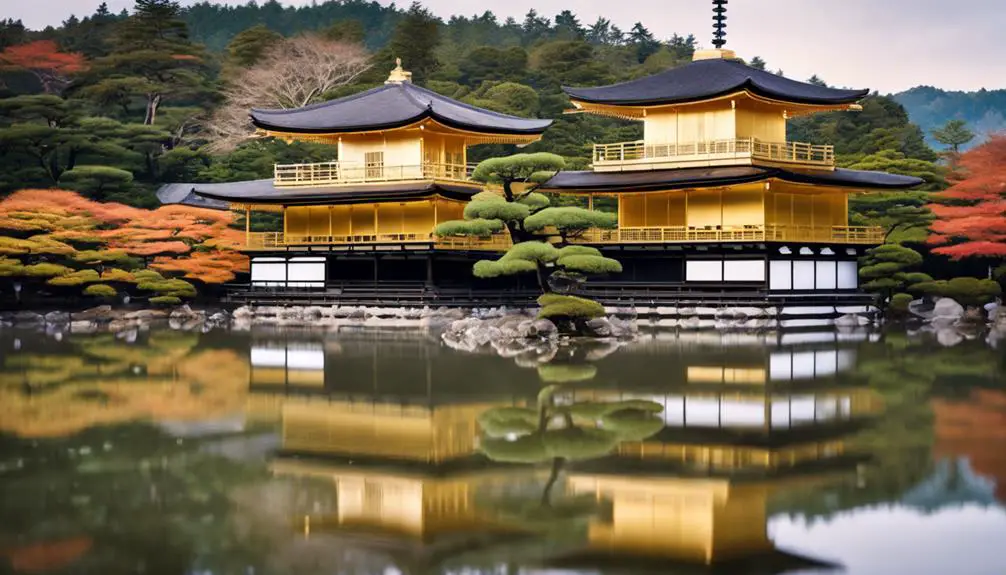
Why not visit Ginkaku-ji next, known as the Silver Pavilion, which, despite its name, is celebrated for its elegant, non-gilded architecture? You'll find that it stands in stark contrast to its more famous cousin, the Golden Pavilion. Here, the beauty lies in its subtlety and understated elegance. Initially intended to be coated in silver, the pavilion's wooden facade was left untouched, embracing the natural aging process that adds to its unique charm.
As you wander through the serene gardens, you'll be captivated by the carefully raked sand of the Ginshadan, representing the sea, and the perfectly placed stones of the Kogetsudai, symbolizing Mount Fuji. These dry landscape elements encourage contemplation and reflection, inviting you to interpret their symbolic meanings.
Don't miss the moss garden, where the vibrant greens provide a lush contrast to the muted tones of the sand and stone. The pathway will lead you through diverse settings, each meticulously crafted to offer a new perspective with every step.
Ginkaku-ji isn't just a site to see; it's a place to experience. Let yourself be drawn into the tranquility and discover the subtle details that make this garden a masterpiece of Japanese aesthetics.
Shoren-in: Moss and Maples
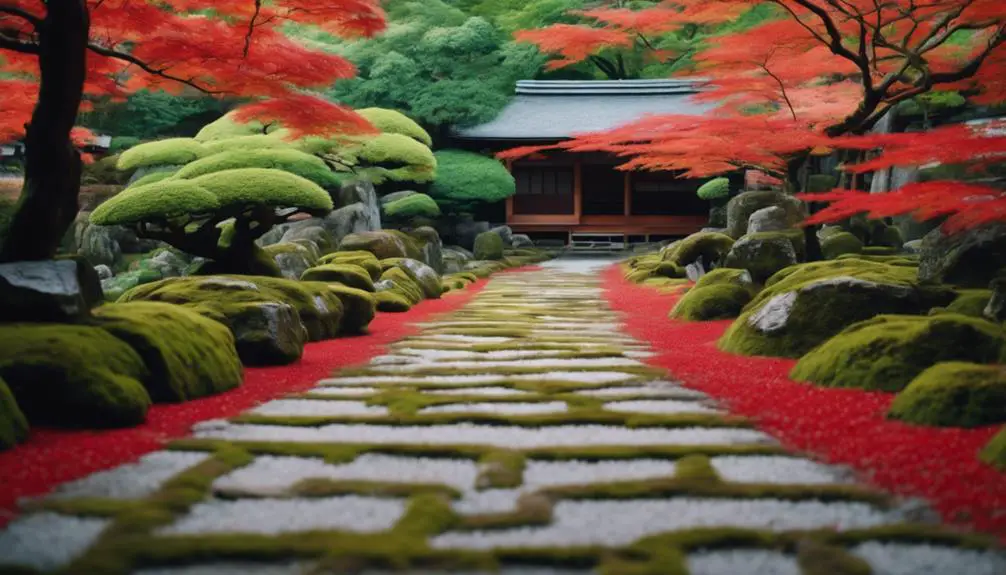
After exploring the understated elegance of Ginkaku-ji, you'll find a different kind of beauty at Shoren-in, where moss and maples create a vivid, enchanting landscape. This temple, nestled in the Higashiyama district of Kyoto, offers you a serene escape from the bustling city.
As you step onto the temple grounds, the lush green moss and fiery red maples contrast sharply, pulling you into a world that seems almost painted.
Walking through Shoren-in, you'll notice the deliberate simplicity and the profound tranquility that encapsulate the essence of a traditional Japanese garden. The air is fresh, filled with the scent of damp earth and leaves, enhancing the sense of immersion in nature.
Here's what makes Shoren-in a must-visit:
- Tranquil Koi Ponds: Reflecting the sky and trees, adding a dynamic yet peaceful element.
- Majestic Camphor Trees: Some over 800 years old, standing as silent witnesses to history.
- Nighttime Illuminations: Transforming the garden into a magical landscape of light and shadows.
- Traditional Tea House: Where you can sip matcha and reflect on the serene surroundings.
- Bamboo Groves: Whispering with the wind, adding a soothing soundtrack to your stroll.
Shoren-in isn't just a garden, it's a journey through the artistry of nature and tradition.
Nanzen-ji: Philosophers' Path
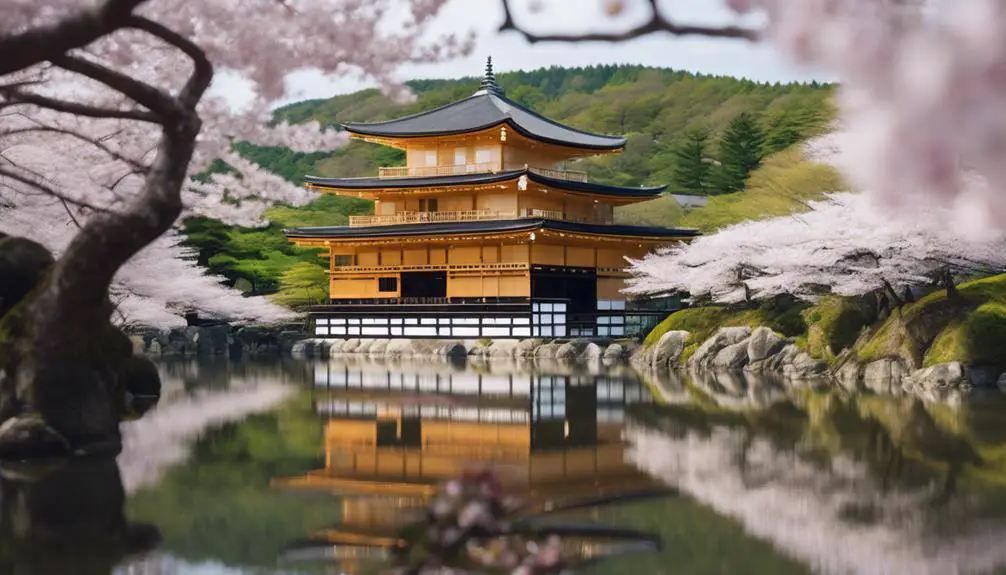
Just a short walk from Shoren-in leads you to Nanzen-ji, renowned for its Philosophers' Path, a place where thinkers once wandered amidst the beauty of nature. As you stroll along this scenic path, you're treading the same ground that inspired Japan's great minds. It's not just a path but a journey through a tunnel of cherry trees, their blossoms creating a delicate pink canopy overhead each spring.
The path runs beside a canal lined with small cafes and artisan shops, offering a perfect blend of natural and cultural beauty. You'll feel the tranquility that must have fueled the philosophers' contemplations, a serene backdrop that encourages your own reflections. Don't rush; let the path lead you, absorb the sights, the sounds, and the soft rustle of leaves.
As the path winds, you'll glimpse Nanzen-ji's massive Sanmon gate, a symbol of the temple's rich history. The architecture here is as thought-provoking as the path itself, with structures that blend effortlessly with the surrounding nature. Each step on this path offers not just a physical journey, but an introspective voyage, inviting you to ponder life's big questions just as those philosophers did centuries ago.
Tenryu-ji: Arashiyama Bamboo Backdrop
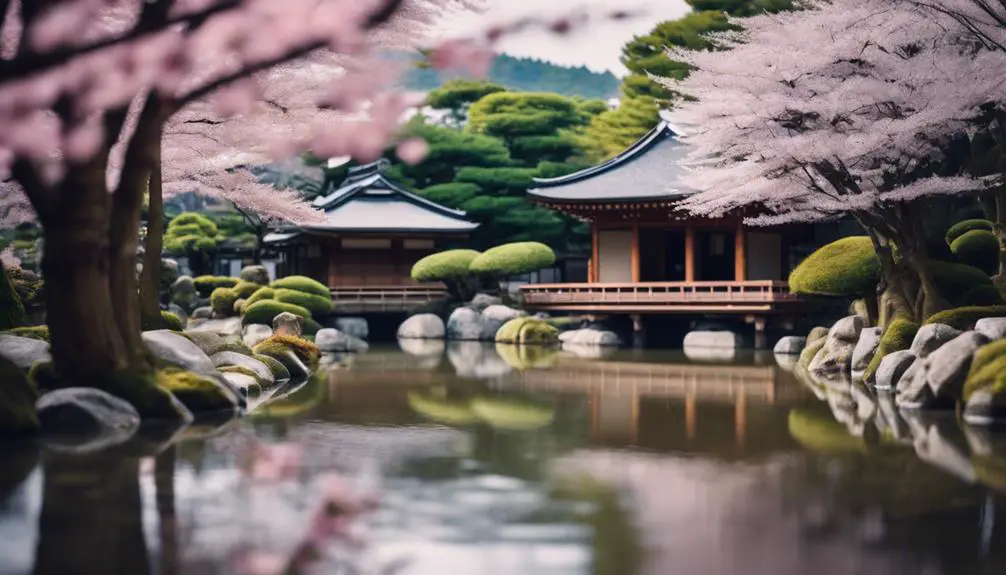
Continuing your journey, explore Tenryu-ji, set against the stunning backdrop of the Arashiyama Bamboo Grove. Known for its historical significance and scenic beauty, this World Heritage Site offers a tranquil escape where nature and history blend harmoniously.
As you wander through the serene landscapes, you'll feel enveloped by the towering bamboo, creating a natural tunnel that shimmers with a magical green light. The garden itself, designed by the famous Zen master Muso Soseki, reflects the essence of Zen aesthetics, emphasizing simplicity and natural beauty.
Here's what makes Tenryu-ji a must-visit:
- *Sogenchi Garden*: A pond garden that has retained its original form since the 14th century.
- *Circular Promenade*: Designed for meditative walks, it allows continuous exploration and reflection.
- *Cloud-Dragon Painting*: Admire the stunning ceiling painting in the main hall, a recent addition that draws the eyes upward.
- *Culinary Delight*: Don't miss the chance to try shojin ryori, a traditional Buddhist vegetarian cuisine.
- *Seasonal Beauty*: Each season brings a new face to Tenryu-ji, from cherry blossoms in spring to fiery maple leaves in fall.
Immerse yourself in the peaceful ambiance and let the timeless beauty of Tenryu-ji inspire your soul.
Heian Shrine: Pond and Cherry Blossoms
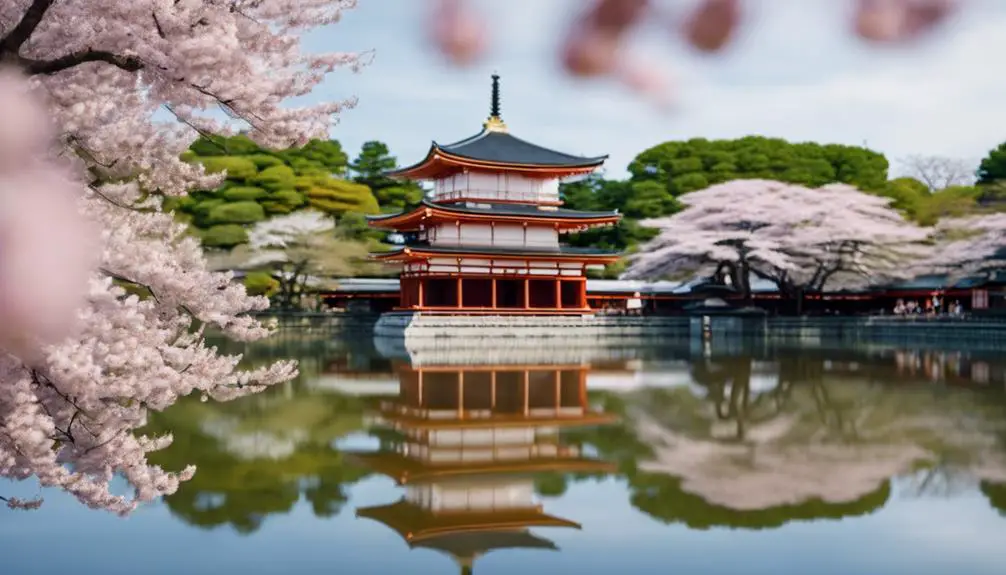
Explore the Heian Shrine, where the expansive pond mirrors the delicate cherry blossoms, creating a breathtaking visual feast. As you stroll around this historic site, you'll find yourself enveloped in a serene atmosphere, punctuated by the soft pink hues of cherry blossoms that float gently on the breeze. The pond itself, a centerpiece of the garden, reflects these blossoms in its glassy surface, doubling the beauty in a spectacular display of nature's symmetry.
You're not just observing a garden; you're experiencing a piece of Kyoto's cultural heritage. Each step you take around the pond offers a new perspective, a fresh burst of color, and a tranquil moment to soak in the scenery. It's easy to see why this spot is favored by locals and tourists alike, especially during the cherry blossom season when the scenery transforms into a living painting.
Don't rush your visit; take your time to sit by the pond, watch the koi fish glide beneath the blossoms, and let the peacefulness wash over you. Remember to bring your camera, as the combination of the Shingon Buddhist architecture and the floral displays provides endless opportunities for stunning photographs.
This magical blend of natural and man-made beauty is what makes Heian Shrine truly unforgettable.
Tofuku-ji: The Great Maple Valley
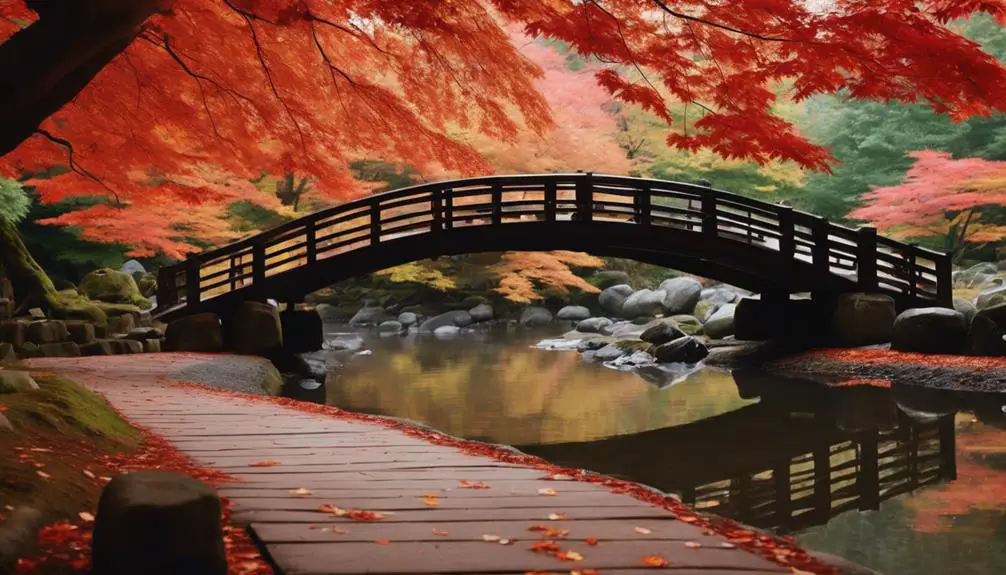
From the serene cherry blossoms at Heian Shrine, shift your focus to the vivid autumnal palette of Tofuku-ji's Great Maple Valley. Here, as you wander through this historic Zen temple, you'll be enveloped by a blazing canopy of maple leaves, transforming with the season's progression. It's as if the trees are ablaze with orange, red, and yellow, creating a tapestry that feels almost magical.
As you step into the valley, you're not just observing nature; you're part of a centuries-old tradition of autumn viewing, known as 'momijigari.' Each turn and corner of Tofuku-ji offers a new vista, a fresh burst of color.
To enhance your visit, keep these points in mind:
- Best Viewing Times: Visit in late November for the most intense colors.
- Tsutenkyo Bridge: Don't miss this iconic spot for a panoramic view of the valley.
- Photography Tips: Early morning light offers the best natural lighting for photos.
- Crowd Avoidance: Weekdays are less crowded, offering a more serene experience.
- Nearby Attractions: Explore the Hojo, famous for its dry landscape garden.
Tofuku-ji's Great Maple Valley isn't just a sight to behold; it's an immersion into the heart of Japanese autumn.
